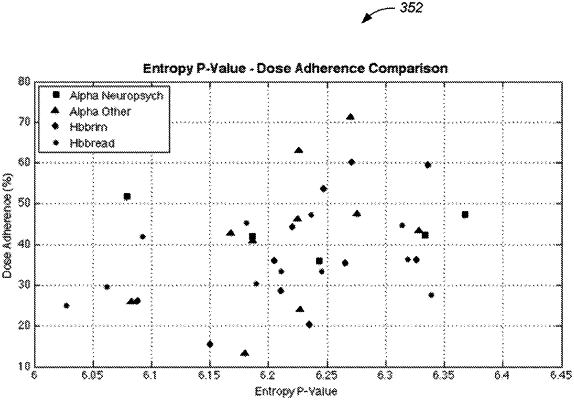| CPC A61B 5/073 (2013.01) [A61B 5/0022 (2013.01); A61B 5/1116 (2013.01); A61B 5/4857 (2013.01); A61B 5/6861 (2013.01); A61B 5/7264 (2013.01); A61B 5/7275 (2013.01); A61B 5/7282 (2013.01); G16H 20/10 (2018.01); G16H 50/30 (2018.01); A61B 5/0024 (2013.01); A61B 5/02055 (2013.01); A61B 5/14539 (2013.01); A61B 5/4833 (2013.01); A61B 2560/0204 (2013.01); A61B 2560/0475 (2013.01); A61B 2562/0219 (2013.01)] | 15 Claims |

|
1. A computer-implemented method, comprising:
receiving, by a computer system, ingestible event marker (IEM) system information wirelessly transmitted from a receiver worn by a subject, the IEM comprising a partial power source of an anode and cathode that is activated in the presence of a conductive liquid, the IEM configured to transmit the IEM system information to the receiver via a conductive signal using the conductive liquid as a transmitting medium, the IEM system information comprising at least IEM-derived medication ingestion compliance information providing an indication that medication containing the IEM has been ingested by the subject, wherein the receiver comprises one or more electrodes that touches the subject to receive the conductive signal from the IEM, and one or more physiologic parameter sensors, and is configured to communicate with the computer system;
receiving, by the computer system, receiver-derived contextual information comprising periodic data of the subject's posture angle, wherein the receiver-derived contextual information is obtained using the one or more physiologic parameter sensors monitoring the subject;
determining, by the computer system, a circadian pattern from the contextual information received from the receiver, the circadian pattern reflecting at least a pattern of the subject's posture across a 24-hour period;
calculating, by the computer system, variability of the circadian pattern, the variability comprising a plurality of ranges in posture angle at regular intervals across the 24-hour period;
quantifying, by the computer system, the variability of the circadian pattern;
determining, by the computer system, a dominant circadian pattern by determining a posture angle for each interval of the regular intervals across the 24-hour period that reduces trend fit error of the dominant circadian pattern when fitted to circadian pattern;
determining, by the computer system, a plurality of deviations between the dominant circadian pattern and the circadian pattern;
calculating, by the computer system, a distribution of the plurality of deviations;
quantifying, by the computer system, the distribution of the plurality of deviations by differential entropy;
calculating, by the computer system, a composite risk score representing an assessment of what type of additional medical intervention is needed, if any, to improve the subject's health, based on a combination of the IEM system information and the quantified plurality of deviations between the dominant circadian pattern and the circadian pattern; and
providing, by the computer system, a recommendation for a medical intervention, if any, to improve the subject's health, based on the composite risk score.
|